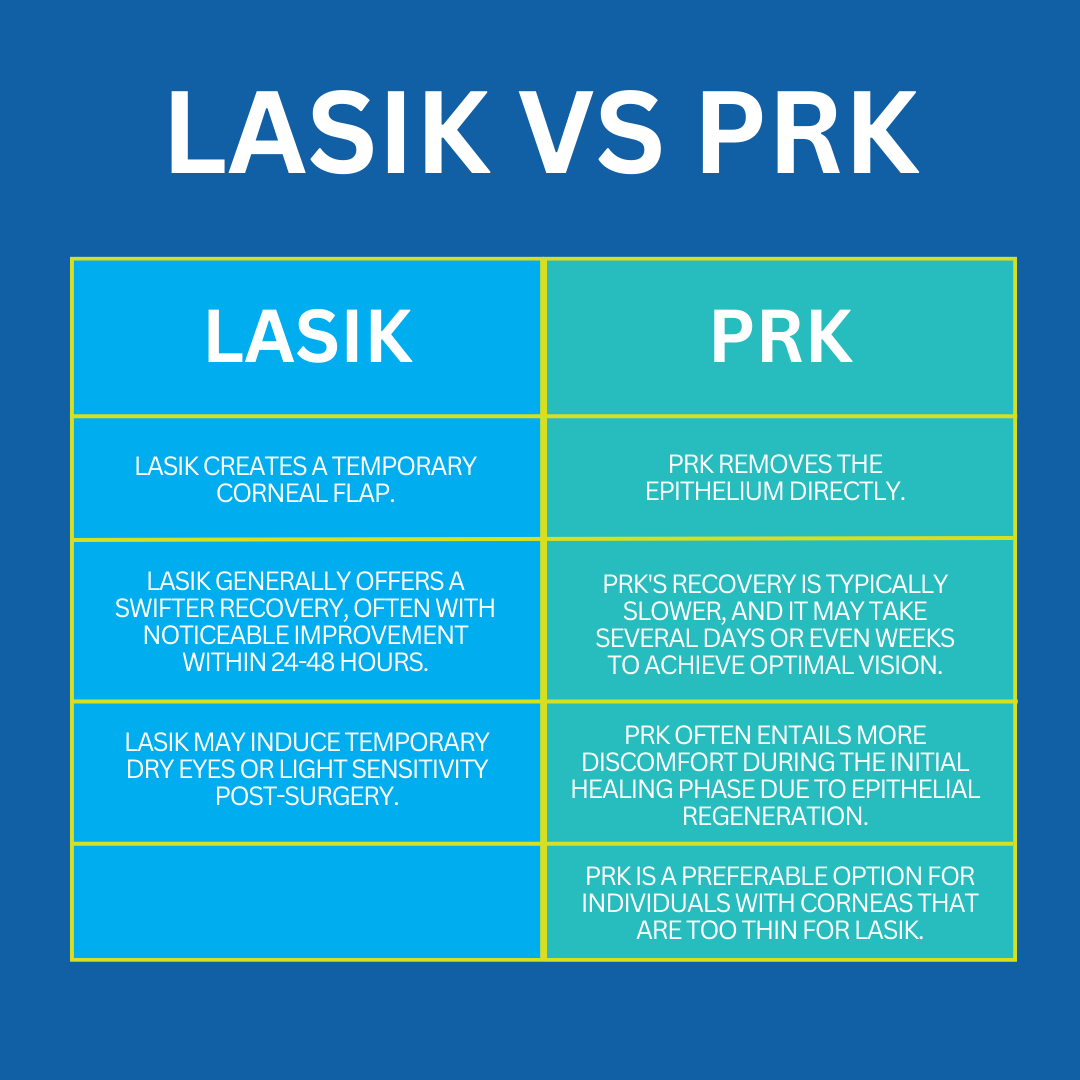
For individuals wanting to shed the constraints of eyeglasses or contact lenses, refractive surgery presents a transformative opportunity. LASIK (Laser-Assisted in Situ Keratomileusis) and PRK (Photorefractive Keratectomy) are two prominent procedures that reshape the cornea, the eye’s outermost layer, to attain clearer vision. But with both vying for your consideration, selecting the optimal solution can be perplexing. We will distinguish the differences between LASIK vs PRK, providing clarity and insight.
LASIK: A Minimally Invasive Approach
The LASIK Procedure
LASIK boasts an ingenious two-step approach. First, a femtosecond laser creates a precise thin, circular flap in the cornea’s outermost layer (epithelium). This flap is gently folded back, exposing the underlying corneal stroma. Next, the excimer laser meticulously ablates (removes) targeted amounts of corneal tissue, reshaping it to rectify refractive errors like myopia (nearsightedness), hyperopia (farsightedness), and astigmatism. The corneal flap is then gently repositioned and naturally adheres without sutures, accelerating the healing process.
Advantages of LASIK Surgery
1. Quick Recovery
Many patients experience a significant improvement in vision within 24 hours, with optimal results manifesting over a few days.
2. Predictable Outcomes
LASIK delivers precise results, with the majority of patients achieving their desired vision correction.
3. Enhanced Comfort
The creation of a corneal flap preserves the surface epithelium, leading to reduced post-operative discomfort.
4. Minimal Maintenance
Following LASIK, most patients enjoy long-term vision stability, minimizing the need for additional procedures.

LASIK Candidacy and Considerations
LASIK surgery is well-suited for individuals with moderate to severe refractive errors who desire rapid visual recovery. Candidates should meet certain criteria, including stable vision prescription, adequate corneal thickness, and absence of certain eye conditions such as keratoconus. While LASIK has revolutionized vision correction, it is not suitable for everyone. Individuals with thin corneas, severe dry eye conditions, or specific corneal irregularities may not be ideal candidates. Additionally, certain professions or activities that involve a high risk of eye injury may preclude the use of LASIK due to the potential for flap dislodgement.
PRK: The Resilient Alternative
The PRK Procedure
PRK adopts a more straightforward approach. The epithelium, the cornea’s outermost layer, is meticulously removed using an excimer laser or mechanical means. Similar to LASIK, the excimer laser meticulously ablates corneal tissue to rectify refractive errors. However, unlike LASIK, PRK doesn’t involve creating a corneal flap. Instead, a natural bandage (epithelial layer) regenerates over the treated area within a few days.
Advantages of PRK Surgery

1. Corneal Preservation
PRK eliminates the risk of flap-related complications, making it a preferred choice for patients with thinner corneas or occupations that pose a higher risk of eye trauma.
2. Suitability for Thin Corneas
Since PRK does not require the creation of a corneal flap, it is often recommended for individuals with thinner corneas who may not be suitable candidates for LASIK.
3. Reduced Risk of Dry Eye
By avoiding the creation of a corneal flap, PRK reduces the risk of post-operative dry eye symptoms.
Candidate Suitability for PRK
PRK is often favored for individuals with thin corneas, certain corneal irregularities, or professions that pose a higher risk of eye trauma. The absence of a corneal flap eliminates the potential for flap-related complications, making PRK a suitable option for those who may not be ideal candidates for LASIK. Candidates should have realistic expectations regarding the recovery process, as visual recovery may be slower compared to LASIK.
Unveiling the Key Distinctions: LASIK vs. PRK
While both LASIK and PRK culminate in improved vision, they diverge in their approaches and suitability for certain individuals. Here’s a closer overview of their core distinctions:

Candidate Selection: Who is Ideal for LASIK or PRK?
The suitability for LASIK or PRK hinges on several factors, including corneal thickness, the nature and severity of your refractive error, and your tolerance for discomfort. Here’s a glimpse into ideal candidates for each procedure:
LASIK: Well-suited for individuals with adequate corneal thickness and who prioritize a swifter recovery.
PRK: Ideal for those with corneas that are too thin for LASIK or individuals engaged in occupations or activities that could dislodge a LASIK flap (e. g., frequent contact sports).
The Ultimate Verdict: LASIK vs PRK?
Both LASIK and PRK surgeries offer effective solutions for correcting refractive errors and achieving clearer vision. While LASIK boasts rapid visual recovery and predictability, PRK provides a safer alternative for individuals with thinner corneas or occupations that predispose them to eye trauma. Ultimately, the optimal selection between LASIK and PRK hinges on a consultation with a qualified ophthalmologist. They will assess your corneal anatomy, refractive error, and overall eye health to determine the most suitable procedure for your unique needs and preferences. Don’t hesitate to voice any concerns or questions you may have throughout the consultation process.
By understanding the nuances of these procedures, you can make an informed decision that aligns with your unique needs and consulting with your ophthalmologist regarding their vision correction journey. Like any surgery, LASIK has risks and potential complications that are discussed during a surgical consultation prior to the procedure. If you have any further questions, please consult with your eye doctor.
Sources:
LASIK — Laser Eye Surgery. (2023, December 11). American Academy of Ophthalmology. https://www.aao.org/eye-health/treatments/lasik
What Is Photorefractive Keratectomy (PRK)? (2023, October 20). American Academy of Ophthalmology. https://www.aao.org/eye-health/treatments/photorefractive-keratectomy-prk


